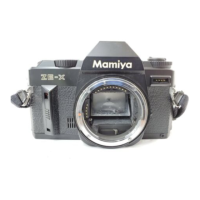
Do you have a question about the Mamiya ZE-X and is the answer not in the manual?
| Film Format | 35mm |
|---|---|
| Lens Mount | Mamiya ZE |
| Viewfinder | Fixed eye-level pentaprism |
| Viewfinder Coverage | 93% |
| Shutter | Electronically controlled vertical metal focal-plane shutter |
| Exposure Modes | Manual, Aperture Priority |
| Exposure Metering | Center-weighted average |
| Focusing Screen | Fixed |
| Type | 35mm SLR |
Camera sets aperture, user controls shutter speed for exposure.
Camera sets shutter speed, user controls aperture for exposure.
Camera automatically sets both shutter speed and aperture.
Automatic aperture control and synchronization with flash units.
Instructions for installing camera batteries.
Steps to load film into the camera.
How to set the film sensitivity (ISO) on the camera.
Guide to choosing automatic exposure modes.
The button used to trigger the camera shutter.
Control for setting the camera's shutter speed.
Device to engage/disengage the crossover system.
The part of the camera used to look through for composing shots.
Steps to mount a lens onto the camera body.
Steps to detach a lens from the camera body.
Explanation of the lens aperture lock button.
Explanation of how camera shake affects photos.
Camera's designed operational limits to prevent shake.
Illustrates how AE adjusts shutter speed and aperture.
How the system corrects slow shutter speed settings.
Illustrates how AE adjusts aperture and shutter speed.
How aperture varies to stay above camera shake limits.
How the camera adjusts settings for different lighting in Program AE.
How the camera works with flash units for automatic exposure.
Flash system that adjusts aperture based on subject distance.
Using flash with EF lenses in Aperture Priority AE.
Using flash with E lenses.
Standard flash exposure indication in the viewfinder.
Flash exposure adjustment via the crossover system.
Indication when subject is out of flash range.
Factors affecting flash charge and exposure.
Using exposure variation for flash.
Key differences from Mamiyalite MZ flash units.
Crossover system does not function with Mamiyalite ZE.
Adjusting exposure using the variation dial or memory button.
How to use the dial for exposure compensation.
Method for direct light reading compensation.
Free selection of aperture and shutter speed for creative control.
Viewfinder indication for manual mode.
Recommendations for long exposure photography.
How to use the camera's self-timer.
Device to block stray light for accurate exposures.
Instructions on how to close the blind.
Steps to create multiple exposures on a single frame.
How aperture affects the area of focus.
Techniques to control background focus.
Special mark for focusing with infrared film.
Manual exposure adjustments for infrared film.
Enables rapid sequential shooting.
Required batteries for the winder operation.
Available filter types for Mamiya lenses.
Prevents internal reflection and flare.
Magnifier, Angle Finder, and Eye-cup for improved focusing and viewing.
Lenses, extension rings, and bellows for macro work.
Indicator for low battery power.
Advice on storing and handling batteries.
Tips on preventing battery drain and damage.
Advice on temperature, humidity, cleaning, and solvents.
Caution regarding tripod mounting and avoiding shocks.
Do not attempt self-repair; consult dealer.
Camera type, modes, picture format, and lens compatibility.
Information on viewfinder display, focusing screen, and metering capabilities.
Details on shutter type, film speed range, and exposure compensation.
Features including self-timer, flash sync, and film advance mechanism.
Physical specifications of the camera body.
